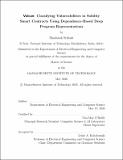| dc.contributor.advisor | Una-May O'Reilly. | en_US |
| dc.contributor.author | Srikant, Shashank. | en_US |
| dc.contributor.other | Massachusetts Institute of Technology. Department of Electrical Engineering and Computer Science. | en_US |
| dc.date.accessioned | 2020-09-15T21:54:08Z | |
| dc.date.available | 2020-09-15T21:54:08Z | |
| dc.date.copyright | 2020 | en_US |
| dc.date.issued | 2020 | en_US |
| dc.identifier.uri | https://hdl.handle.net/1721.1/127365 | |
| dc.description | Thesis: S.M., Massachusetts Institute of Technology, Department of Electrical Engineering and Computer Science, May, 2020 | en_US |
| dc.description | Cataloged from the official PDF of thesis. | en_US |
| dc.description | Includes bibliographical references (pages 49-51). | en_US |
| dc.description.abstract | As domain specific languages such as Solidity for Ethereum have emerged to program blockchain distributed ledgers, domain-specific bugs and vulnerabilities have reciprocally arisen. In this thesis, I propose a machine learning approach to designing classifiers which can flag specific lines of programs containing such vulnerabilities. This classification task calls for reasoning beyond what tokens are in a line to reasoning about how each token lies within a control context (e.g. loop) and how its meaning depends on its preceding definition. We present a neural architecture, Vulcan, which employs a distributed representation in a latent feature space to express these properties, while ensuring that lines of similar meaning have similar features. Using paths of the program's abstract syntax tree (AST), Vulcan inputs contextual information about tokens in a line to a bi-directional LSTM with an attention mechanism. It concurrently represents the meaning of a token in a line by recursively embedding all preceding lines where it is defined. In our experiments, Vulcan compares favorably with a state-of-the-art classifier that requires significant preprocessing of programs, suggesting the utility of using deep learning to model program dependence information. | en_US |
| dc.description.statementofresponsibility | by Shashank Srikant. | en_US |
| dc.format.extent | 57 pages | en_US |
| dc.language.iso | eng | en_US |
| dc.publisher | Massachusetts Institute of Technology | en_US |
| dc.rights | MIT theses may be protected by copyright. Please reuse MIT thesis content according to the MIT Libraries Permissions Policy, which is available through the URL provided. | en_US |
| dc.rights.uri | http://dspace.mit.edu/handle/1721.1/7582 | en_US |
| dc.subject | Electrical Engineering and Computer Science. | en_US |
| dc.title | Vulcan : classifying vulnerabilities in solidity smart contracts using dependency-based deep program representations | en_US |
| dc.title.alternative | Classifying vulnerabilities in solidity smart contracts using dependency-based deep program representations | en_US |
| dc.type | Thesis | en_US |
| dc.description.degree | S.M. | en_US |
| dc.contributor.department | Massachusetts Institute of Technology. Department of Electrical Engineering and Computer Science | en_US |
| dc.identifier.oclc | 1192495700 | en_US |
| dc.description.collection | S.M. Massachusetts Institute of Technology, Department of Electrical Engineering and Computer Science | en_US |
| dspace.imported | 2020-09-15T21:54:08Z | en_US |
| mit.thesis.degree | Master | en_US |
| mit.thesis.department | EECS | en_US |
